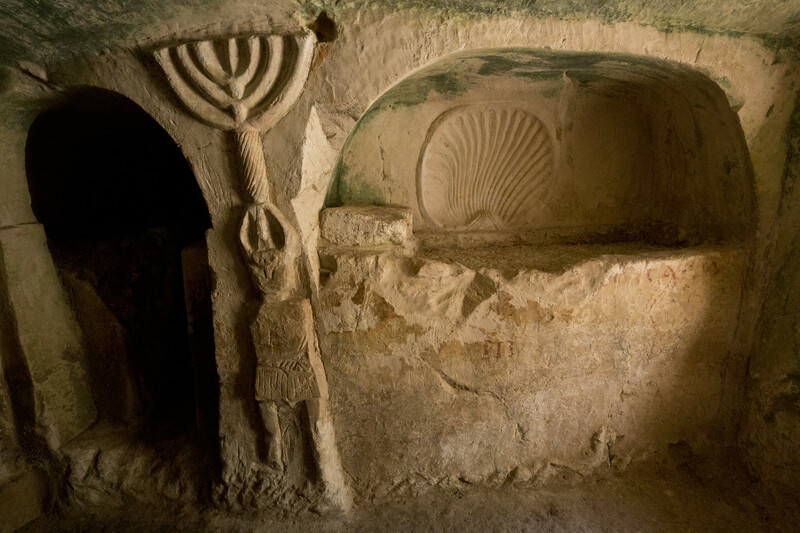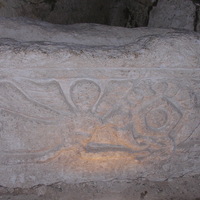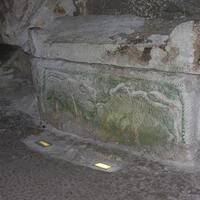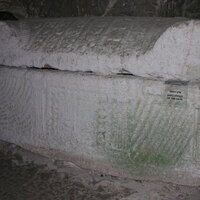Beth She'arim catacombs
Date:
Second to fourth century
Location or Findspot (Modern-Day Country):
Israel
Description:
Beth She'arim (northern Israel) was a Jewish village with an extensive series of catacombs—excavated underground burial corridors that widen at intervals into larger chambers. The tombs, which date back as far as the second century, include inscriptions in a range of languages (Hebrew, Greek, Aramaic). Their inscriptions also reveal that the catacombs were the final resting place of Jews from cities as far away as Syria, Turkey, and South Mesopotamia. Wealthy Jews, like other Romans, sometimes buried their dead in stone sarcophagi, but other methods could also be used. Hidden behind decorated stone doors, intact bodies were placed into pits in the floor, slots in the wall (kokhim in Hebrew, loculi in Latin), more elaborate arched wall tombs (arcosolia; singular arcosolium) containing one or more troughs, or freestanding sarcophagi.
One of the Jews in the Beth She'arim catacombs was the wealthy and pious Judah ha-Nasi (the Prince or Patriarch), a friend of Marcus Aurelius and head of the Jewish community in the Roman province of Palestine. The Prince was famous for compiling the Mishnah, a guidebook to Jewish law based on accumulated oral commentaries on the Torah. He foresaw that the Jews were becoming more scattered and might forget the oral traditions, including those that pertained to the (destroyed) Temple of Jerusalem. He had expressed a wish not to be interred in a sarcophagus, and so Judah was buried alongside his wife in the floor of catacomb 14 around 220 CE. His tomb became the nucleus of a family burial space, with a bench carved into the perimeter for visitors. It also became a magnet for Jews from Palestine and the diaspora who wanted to be buried near the great rabbi ("teacher" or "master") in the land of Israel. They hoped to be resurrected alongside him in the time of the Messiah. This phenomenon of being buried in a special or even a sanctified place became a hallmark of medieval practice.
In catacomb 4, the main room contains the Greek inscription "Leontius of Palmyra, banker" and the tomb shown here is inscribed with a Palmyrene name, so it likely belonged to a family member or other Jews from that cosmopolitan city in Syria. This elaborate tomb, perhaps of the third century, is accessed through an arch decorated with a menorah in relief and incised red rosettes. It contains two shelf graves that imitate freestanding sarcophagi. The back wall has an arcosolium with two trough graves above a projecting plinth flanked by lions, one outlined in red and the other in relief. The massive main graves have relief carvings at the visible ends that depict a four-column facade with an arched lintel. On the better-carved left tomb this is decorated with a conch shell and a lion; on the right is a menorah, a lion, a lulav (closed palm frond, for the Jewish autumn holiday of Sukkot), and a human figure. The facades resemble the built shrines found in later synagogues, which have one structure to hold the Torah and another for a menorah, in imitation of the lost Temple.
Freestanding sarcophagi elsewhere at Beth She'arim bear a range of decoration: standard Roman and local imagery, such as eagles, wreaths, lions, winged victories, and mythological scenes, including several battles between Greeks and Amazons and Leda with the swan. The Leda sarcophagus, made of costly marble rather than local limestone, must have been imported by extremely wealthy patrons who were proud of their classical knowledge and did not consider it to be in conflict with their Jewish faith.
One of the Jews in the Beth She'arim catacombs was the wealthy and pious Judah ha-Nasi (the Prince or Patriarch), a friend of Marcus Aurelius and head of the Jewish community in the Roman province of Palestine. The Prince was famous for compiling the Mishnah, a guidebook to Jewish law based on accumulated oral commentaries on the Torah. He foresaw that the Jews were becoming more scattered and might forget the oral traditions, including those that pertained to the (destroyed) Temple of Jerusalem. He had expressed a wish not to be interred in a sarcophagus, and so Judah was buried alongside his wife in the floor of catacomb 14 around 220 CE. His tomb became the nucleus of a family burial space, with a bench carved into the perimeter for visitors. It also became a magnet for Jews from Palestine and the diaspora who wanted to be buried near the great rabbi ("teacher" or "master") in the land of Israel. They hoped to be resurrected alongside him in the time of the Messiah. This phenomenon of being buried in a special or even a sanctified place became a hallmark of medieval practice.
In catacomb 4, the main room contains the Greek inscription "Leontius of Palmyra, banker" and the tomb shown here is inscribed with a Palmyrene name, so it likely belonged to a family member or other Jews from that cosmopolitan city in Syria. This elaborate tomb, perhaps of the third century, is accessed through an arch decorated with a menorah in relief and incised red rosettes. It contains two shelf graves that imitate freestanding sarcophagi. The back wall has an arcosolium with two trough graves above a projecting plinth flanked by lions, one outlined in red and the other in relief. The massive main graves have relief carvings at the visible ends that depict a four-column facade with an arched lintel. On the better-carved left tomb this is decorated with a conch shell and a lion; on the right is a menorah, a lion, a lulav (closed palm frond, for the Jewish autumn holiday of Sukkot), and a human figure. The facades resemble the built shrines found in later synagogues, which have one structure to hold the Torah and another for a menorah, in imitation of the lost Temple.
Freestanding sarcophagi elsewhere at Beth She'arim bear a range of decoration: standard Roman and local imagery, such as eagles, wreaths, lions, winged victories, and mythological scenes, including several battles between Greeks and Amazons and Leda with the swan. The Leda sarcophagus, made of costly marble rather than local limestone, must have been imported by extremely wealthy patrons who were proud of their classical knowledge and did not consider it to be in conflict with their Jewish faith.
Relevant Textbook Chapter(s):
1
Repository and Online Resources:
• The catacombs of Beth She'arim are part of UNESCO's World Heritage List.
Image Credits:
Dror Maayan; Linda Safran; Wikimedia Commons; Flickr, Alex Brey
Tags:
Jewish,
Western Asian,
Status and identity,
Animals,
Aramaic,
Burial and tombs,
Greek,
Hebrew










